From Clinical Trials to Real-World Practice, Experts Examine the Best Options for TNBC
During a live Tweet Chat, Hope S. Rugo, MD, and Paolo Tarantino, MD, reviewed a patient case and discussed current standard of care for those with metastatic triple-negative breast cancer.
CancerNetwork® recently hosted a first-of-its-kind Tweet Chat with co-hosts Hope S. Rugo, MD, and Paolo Tarantino, MD. Together, they reviewed a patient case of a 52-year-old woman who had been diagnosed with stage IIA triple-negative breast cancer (TNBC) and went into detail regarding treatment options for the metastatic population.
Rugo, a professor of medicine, and director of Breast Oncology and Clinical Trials Education at the University of California San Francisco Helen Diller Comprehensive Cancer Center; and Tarantino, a Clinical Research Fellow at Dana-Farber Cancer Institute, also examined the use of neoadjuvant therapeutics for early disease and potential adjuvant therapy-sparing regimens.
Patient Case
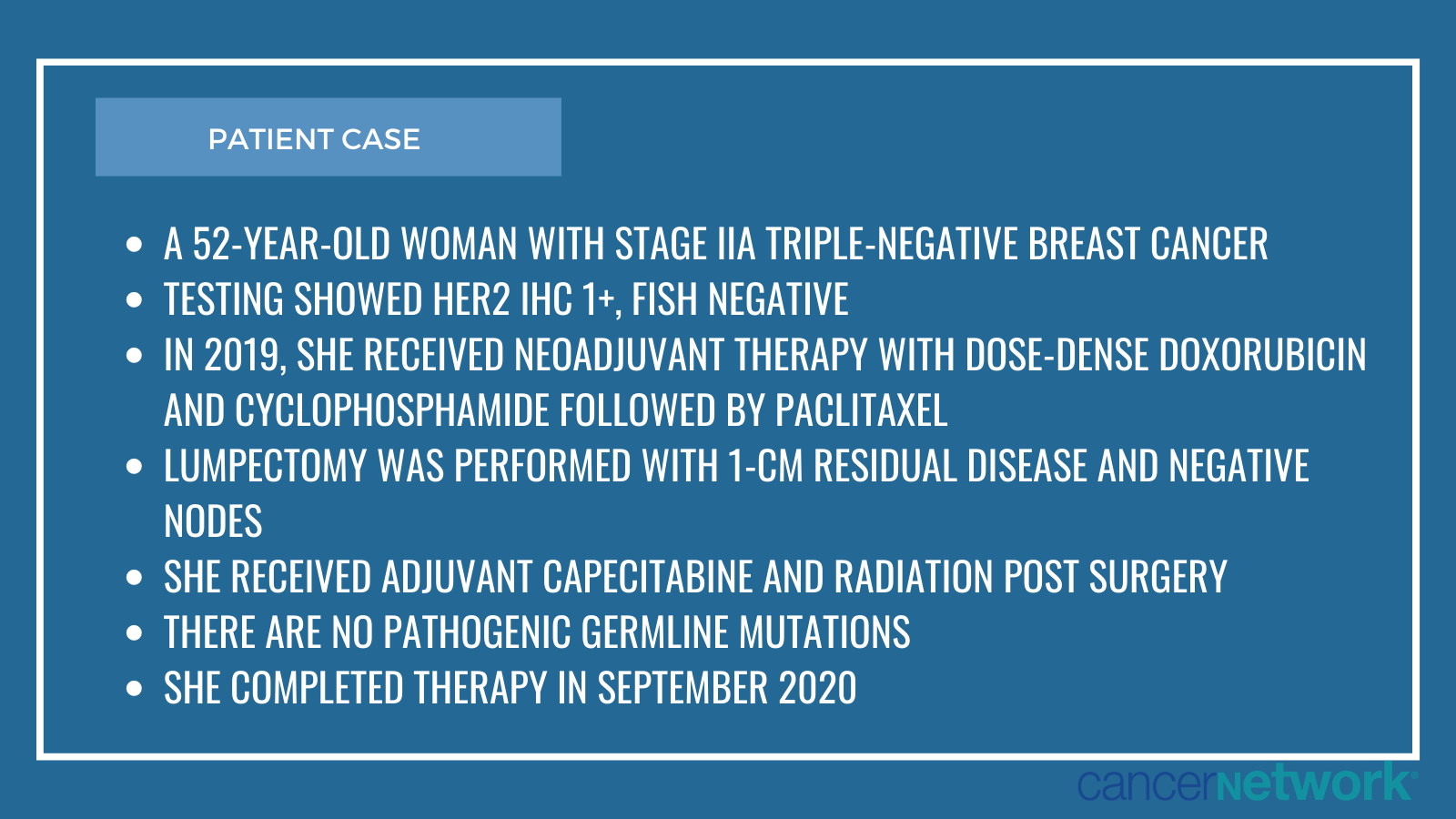
During the live Tweet Chat, both experts detailed the impact of antibody-drug conjugates (ADCs) on survival outcomes and the best approach for treating patients following disease recurrence after first-line therapy.
Patient Case Continued
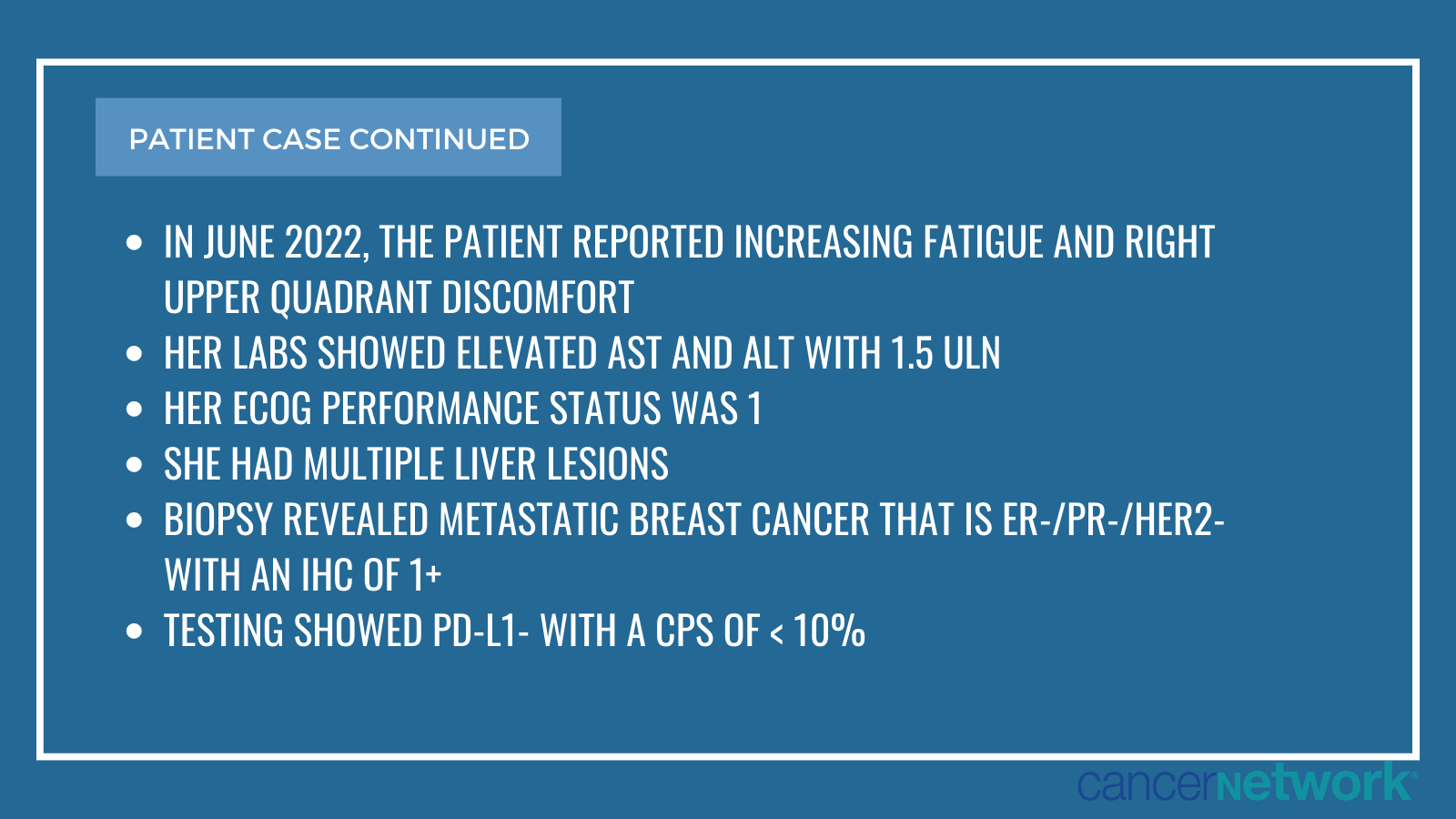
In the first part of the patient case of a 52-year-old woman with stage IIA TNBC, Rugo mentioned the need for neoadjuvant chemotherapy, “We recommend [neoadjuvant chemotherapy] in this case, following the KN522 regimen. The [addition] of [pembrolizumab increases] pCR and EFS. @SABCS22 Gupta showed better outcomes adding platinum to T/[adjuvant chemotherapy].”
Tarantino responded with results from the phase 3 KEYNOTE-522 trial (NCT03036488) wherein patients with TNBC received pembrolizumab (Keytruda) plus chemotherapy vs placebo as a neoadjuvant treatment and pembrolizumab vs placebo as adjuvant treatment.1
Review of efficacy from the phase 3 CREATE-X trial

Rugo questioned if there is a need to wait a year after starting pembrolizumab for a partial complete response (pCR) to be observed and, if not, whether capecitabine/pembrolizumab is a good alternative treatment option.
Additionally, she introduced several studies assessing sacituzumab govitecan-nxki (Trodelvy) in patients with TNBC, “OptimICE pCR is an ALLIANCE trial that will randomize [patients] to [pembrolizumab] or not in those with pCR. OptimICE RD and the [phase 3] SASCIA trial [NCT04595565] are evaluating the addition of sacituzumab govitecan in patients with residual disease.”
In response, Tarantino discussed data from phase 2 GeparNuevo trial (NCT02685059) which added a PD-L1 antibody to taxane chemotherapy.2 In this trial, patients had a high invasive disease-free survival. While OptimICE-pCR is still enrolling patients, he hopes that the results will show the ability to spare adjuvant immunotherapy.
Next steps of treatment was also a topic of conversation, as the patient experienced recurrence after adjuvant capecitabine and radiation.
Tarantino responded that chemotherapy and taxane rechallenge is the current standard of care for recurrent TNBC, “[Chemotherapy], with a taxane rechallenge [is] reasonable given [the] long time since completion of [adjuvant taxane].”
Results from the ASCENT trial presented at 2022 ASCO
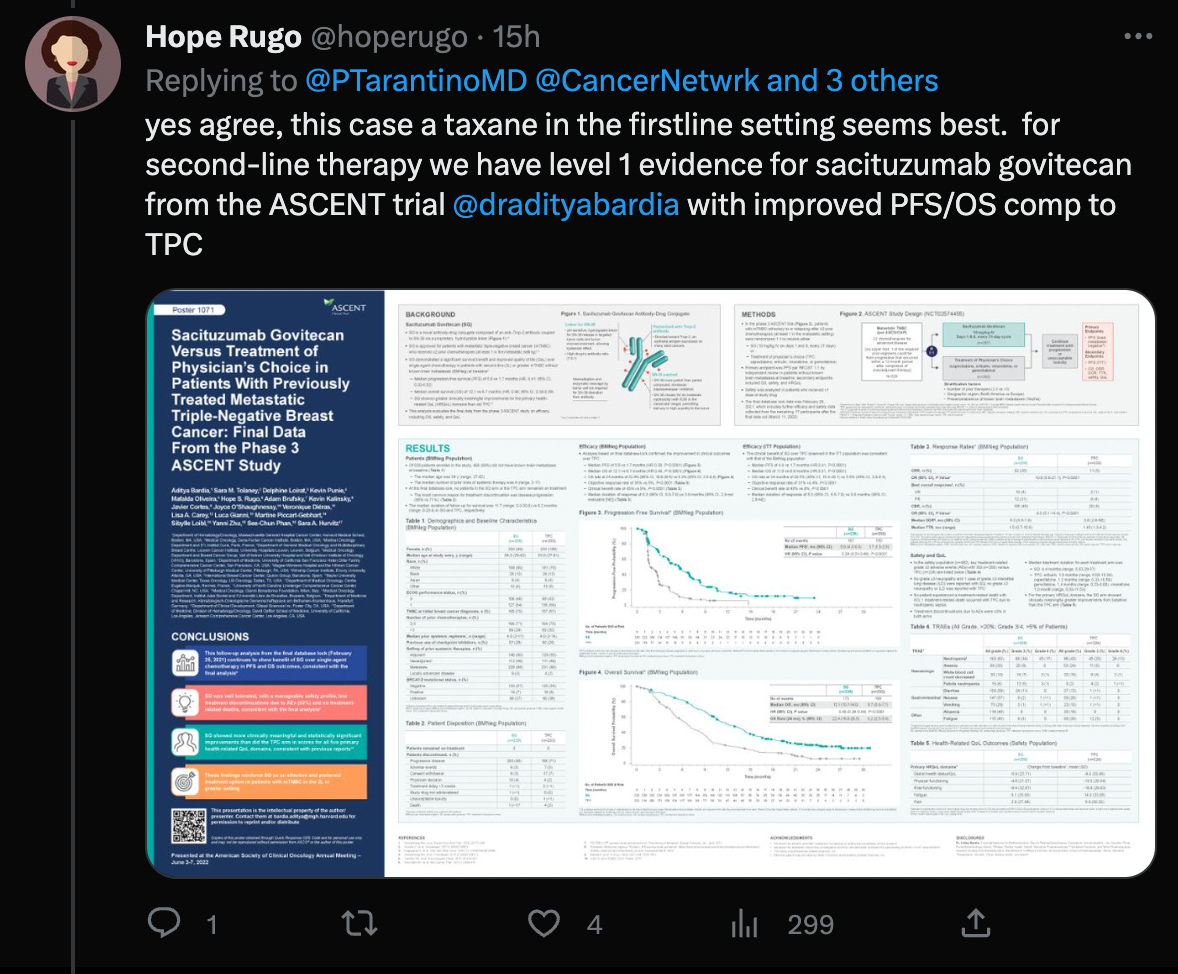
When asked if she agreed with his reasoning behind using taxane in the first-line setting and sacituzumab govitecan in the second-line, Rugo mentioned the phase 3 ASCENT trial (NCT02574455), which had final data read out at the 2022 American Society of Clinical Oncology (ASCO) Annual Meeting, supported this thought process She mentions that this trial then led to the approval of sacituzumab govitecan in the second-line setting for patients with TNBC.3,4
Another study that was presented at ASCO and, according to Tarantino, showed impressive results was the phase 3 DESTINY-Breast04 trial (NCT03734029) which analyzed fam-trastuzumab deruxtecan-nkxi (Enhertu) in patients with HER2-low breast cancer.5
The phase 3 DESTINY-Breat04 trial which was a "game changer", according to Tarantino.
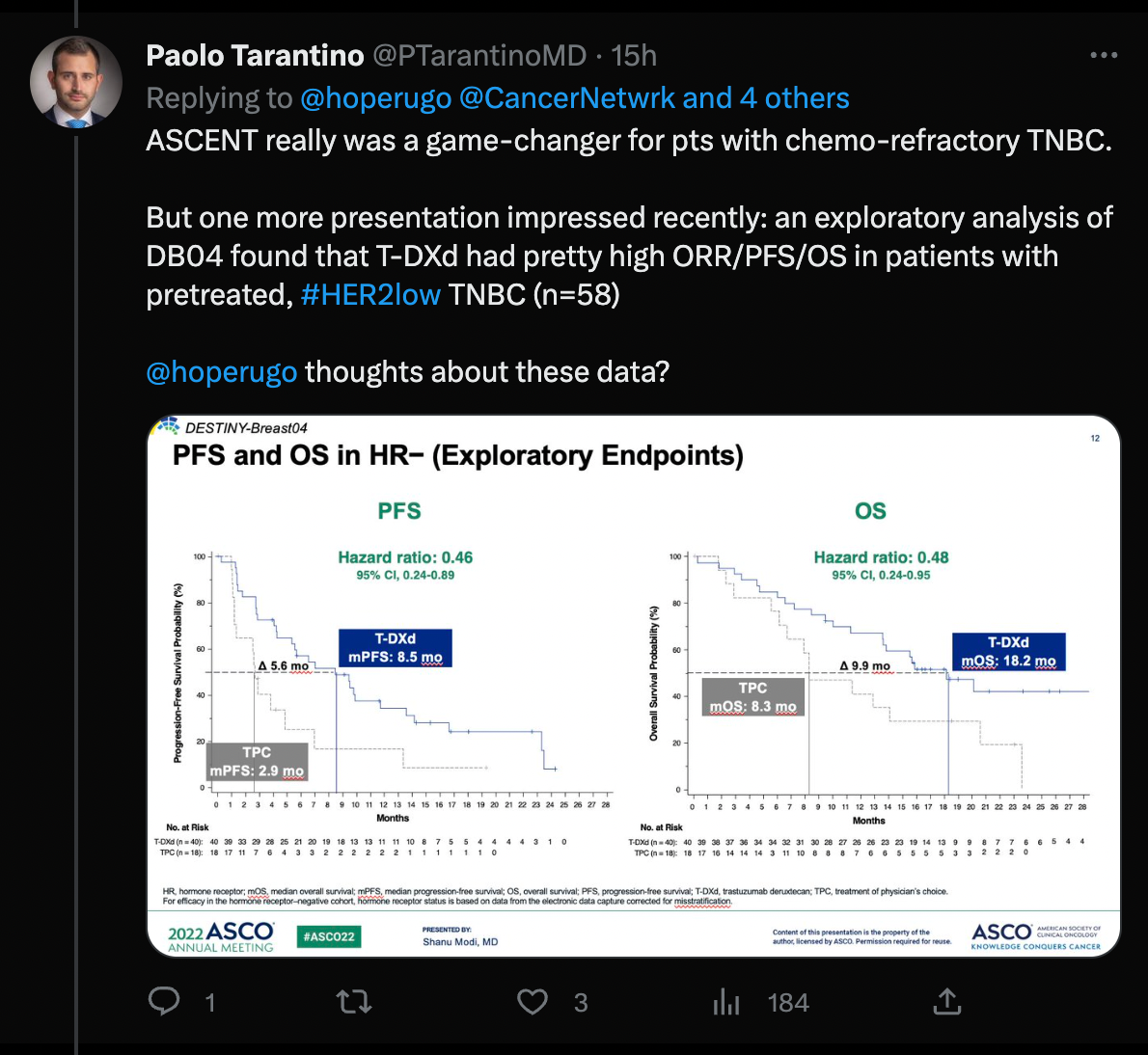
In response to data from the DESTINY-Breast04 trial that Tarantino presented, Rugo said, “Really incredible data from DB04 for HR+ and encouraging in TNBC; just [important] to remember that [there were] only 58 pts so 18 in the control arm. And only 1/3 of TNBC [cases] are HER2 low.”
Rugo also mentioned the ongoing phase 3 ASCENT-03 trial (NCT05382299) examining sacituzumab govitecan vs physician’s choice therapy in previously untreated metastatic TNBC. There is also the phase 3 ASCENT-04 trial (NCT05382286) assessing sacituzumab govitecan plus pembrolizumab vs physician’s choice plus pembrolizumab previously untreated, locally advanced inoperable or metastatic TNBC. Both of these trials utilized sacituzumab govitecan as second-line treatment.
Tarantino and Rugo also touched on trials involving ADCs such as the phase 1/2 BEGONIA trial (NCT03742102), assessing durvalumab (Imfinzi), capivasertib, oleclumab, paclitaxel, trastuzumab deruxtecan, and datopotamab deruxtecan for patients with metastatic TNBC.6 To better support the data presented with BEGONIA, Tarantino posted a graphic detailing the change from baseline target lesion size and the change from baseline of the number of target lesions over time.
When asked how they would treat a patient if progression occurred 3 months after initial treatment with first-line therapy, Rugo responded, “Good question, and tragic situation; in this case, we treat as if we are second line, so [we] would use sacituzumab govitecan first-line. At least that is my approach. @PTarantinoMD?If PD-L1 positive how would you treat?”
The phase 1/2 BEGONIA trial showed an improved objective response rate with Dato+DXd
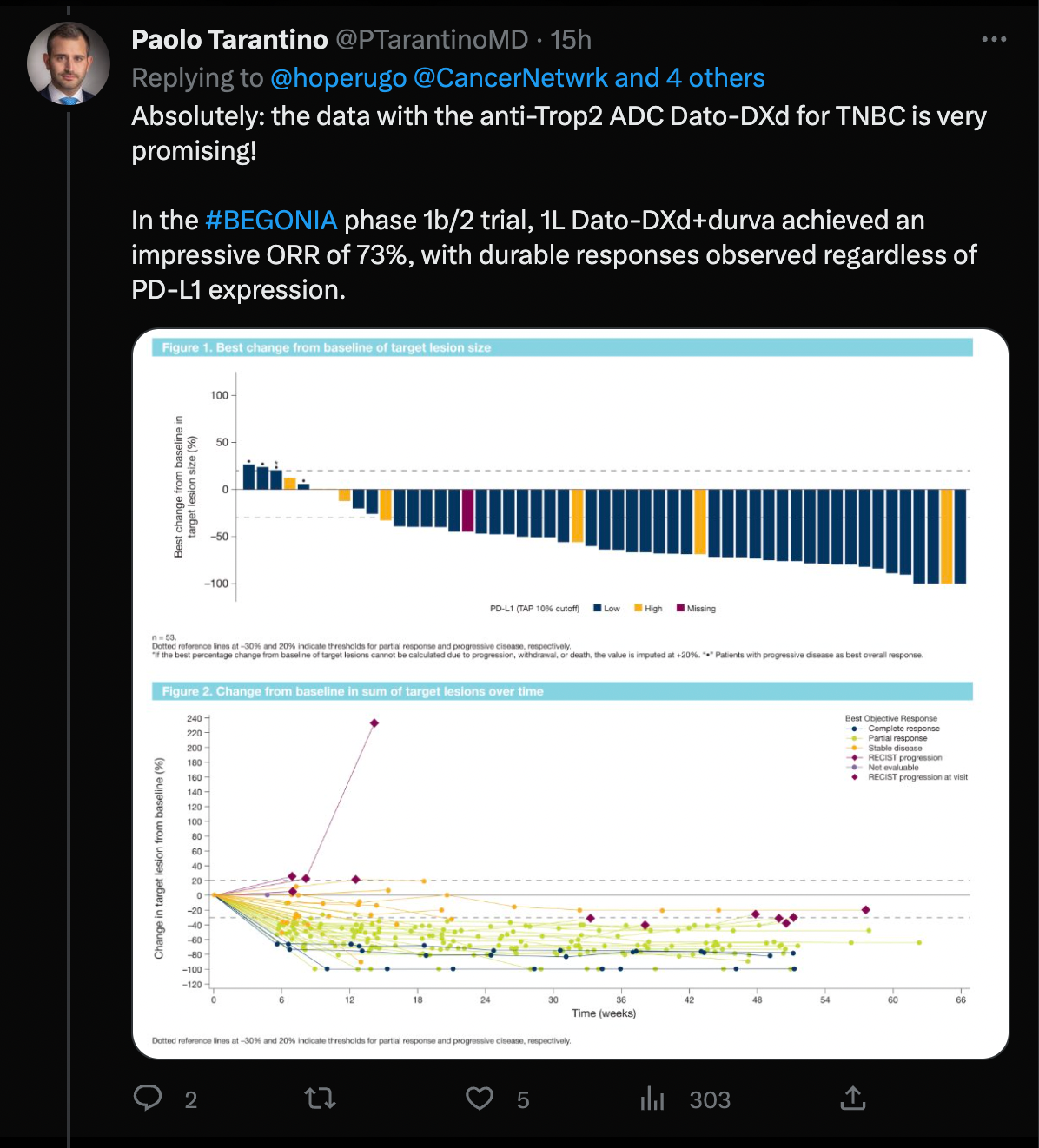
Tarantino noted that if a patient is PD-L1 positive, it is worth it to combine first-line pembrolizumab plus chemotherapy. He referenced the phase 3 KEYNOTE-355 trial (NCT02819518) as an example of when to use this treatment combination.7
The phase 3 KEYNOTE-355 trial evaluated pembrolizumab plus chemotherapy vs placebo and showed improved overall survival.
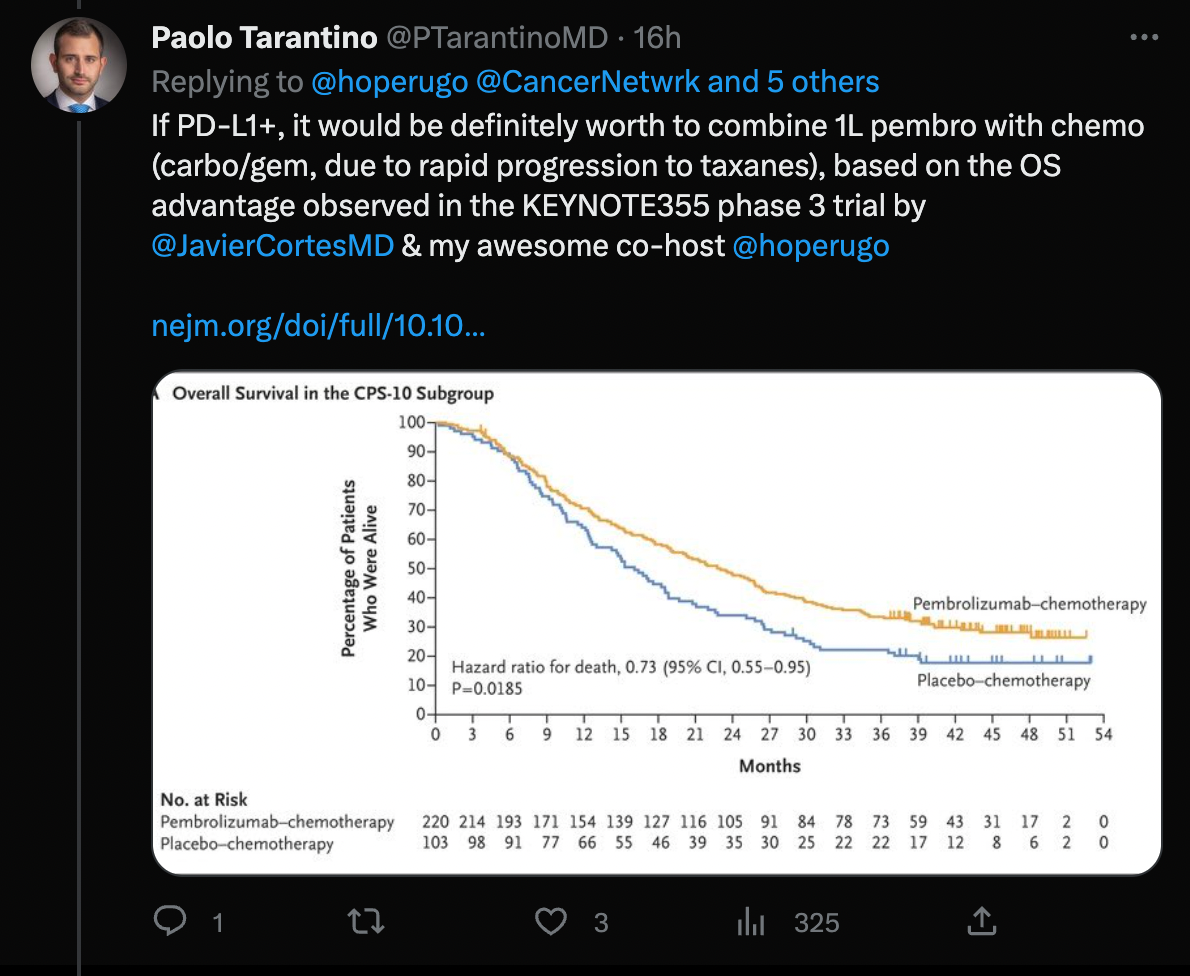
Rugo agreed with Tarantino’s recommended course of action, but questioned if the patient was on single arm pembrolizumab at the time of progression, what should be the standard of care? Tarantino noted this was a hard question but said that he would be inclined to administer treatment as though the patient was in the second line, moving to an ADC.
He then inquired if the patient had a BRCA mutation, would it change the choice of treatment.
Rugo responded with results from the phase 3 OlympiAD trial (NCT02000622) that focused on the use of olaparib in patients with a BRCA mutation.
When using PARP inhibitors in treatment, Rugo referenced the phase 3 OlympiAD trial
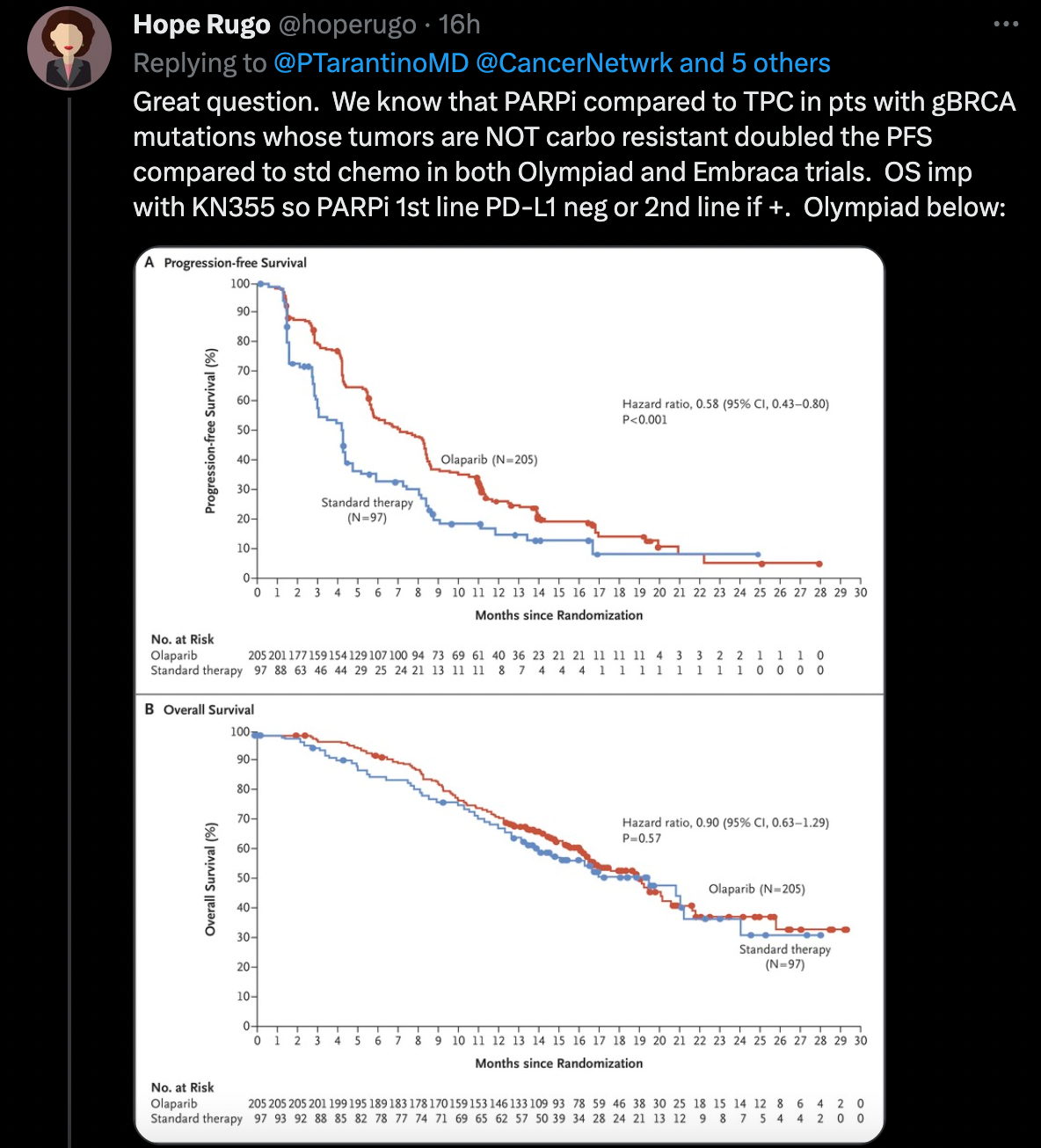
Survival was also improved in the phase 3 EMBRACA trial (NCT01945775), assessing talazoparib in patients with advanced breast cancer who had a germline BRCA mutation.
In closing, Rugo said she is interested in seeing outcomes with the use of maintenance PARP inhibitors after response is achieved, specifically those with BRCA mutations. Tarantino responded that PARP maintenance is a very interesting strategy and could even have use in other populations outside of those with BRCA mutations.
To view the full Tweet Chat, visit, https://bit.ly/3XKj1bk
References
- Schmid P, Cortes J, Pusztai L, et al. Pembrolizumab for early triple-negative breast cancer. N Engl J Med. 2020;382(9):810-821. doi:10.1056/NEJMoa1910549
- Loibl S, Schneeweiss A, Huober J, et al. Neoadjuvant durvalumab improves survival in early triple-negative breast cancer independent of pathological complete response. Ann Oncol. 2022;33(11):1149-1158. doi:10.1016/j.annonc.2022.07.1940
- Final data from phase 3 ASCENT study demonstrates Trodelvy extends overall survival over chemotherapy in second-line metastatic TNBC. News release. Gilead. June 6, 2022. Accessed January 27, 2022. https://bit.ly/40aDYh8
- FDA grants regular approval to sacituzumab govitecan for triple-negative breast cancer. News release. FDA. April 7, 2021. Accessed January 27, 2023. https://bit.ly/3Hae98x
- Modi S, Jacot W, Yamashita T, et al. Trastuzumab deruxtecan in previously treated HER2-low advanced breast cancer. N Engl J Med. 2022; 387(1):9-20. doi:10.1056/NEJMoa2203690
- Loibl S, Schneeweiss A, Huober J, et al. Neoadjuvant durvalumab improves survival in early triple-negative breast cancer independent of pathological complete response. Ann Oncol. 2022;33(11):1149-1158. doi:10.1016/j.annonc.2022.07.1940
- Cortes J, Rugo HS, Cescon DW, et al. Pembrolizumab plus chemotherapy in advanced triple-negative breast cancer. N Engl J Med. 2022;387(3):217-226. doi:10.1056/NEJMoa2202809
Newsletter
Stay up to date on recent advances in the multidisciplinary approach to cancer.
Phase 3 Trial of Trilaciclib in Triple-Negative Breast Cancer Will Continue
February 13th 2024The final overall survival analysis of trilaciclib plus chemotherapy in patients with metastatic triple-negative breast cancer as part of the PRESERVE 2 trial will take place in the third quarter of 2024.